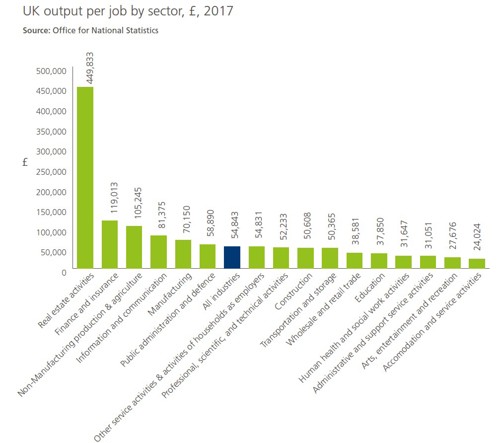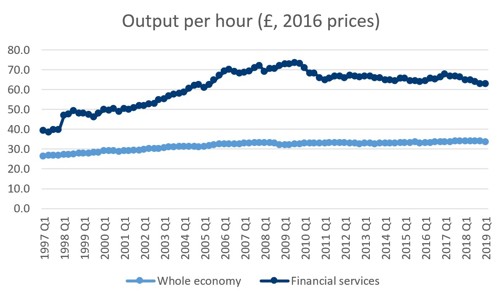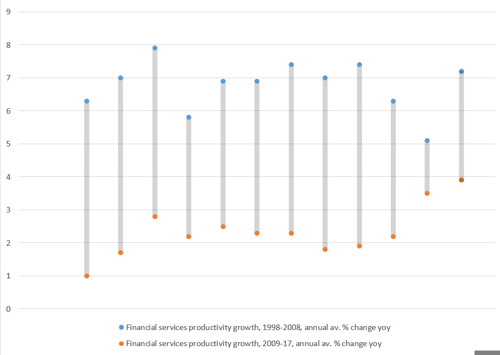New data allow us to build on earlier analysis to examine financial services productivity on a regional basis.
Our recent economic research, ‘Key Facts about UK-based financial and related professional services’, is probably familiar to readers of this blog as being our annual research quantifying the contribution of the industry to the UK economy. As well as highlighting the industry’s role in providing savings, insurance, business lending and other services, this year’s report included data showing that financial services productivity is the second-highest of all UK industries:

I had written previously about economy-wide region-level productivity, and also about financial services productivity in this post last year. There I observed that financial services productivity across the UK is twice as high as the average productivity across all industries; the latest data demonstrating this is shown here:

New data released by the Office for National Statistics now allow us to delve deeper into this topic and analyse financial services productivity at a regional level. As one would expect given London’s role as the world’s leading international financial services centre and its globally competitive, export-oriented financial services sector, industry productivity in London (output per job of around £177,000) far exceeds industry productivity in the UK as a whole (around £119,000). In the other 11 regions, financial services productivity ranges from 60-80% of the overall UK level of financial services productivity.
Although regional divergence in financial services productivity is evident, looking at financial services productivity compared to overall productivity shows very similar results across the regions. As observed earlier, financial services productivity is twice as high as overall productivity across the UK—and the new regional data show that this is true not only in the aggregate, but in every individual UK region and nation: the multiplier ranges from 1.6 in Wales to 2.4 in London. We can also compare financial services productivity to productivity in other services sectors (including, but not limited to, trade, information and communication, real estate, professional, scientific, and technical activities, and education). The result is similar, with the multiplier ranging from 1.8 in Northern Ireland, the North East, East Midlands and Wales, to 2.6 in London.
The availability of time-series data also allows us to compare regional financial services productivity before the 2008-09 financial crisis and afterwards. The data show that overall, the pre-crisis and post-crisis periods were quite similar in that the majority of UK regions experienced industry productivity growth rates below—but not very far below—the UK average, as seen in the table below).
|
Region |
Financial services productivity growth, 1998-2008, annual av. % change yoy
|
Financial services productivity growth, 2009-17, annual av. % change yoy
|
|
Yorkshire & the Humber |
7.2 |
3.9 |
|
West Midlands |
5.1 |
3.5 |
|
UK |
7.2 |
2.9 |
|
London |
7.9 |
2.8 |
|
North West |
6.9 |
2.5 |
|
Northern Ireland |
6.9 |
2.3 |
|
Scotland |
7.4 |
2.3 |
|
Wales |
6.3 |
2.2 |
|
North East |
5.8 |
2.2 |
|
South West |
7.4 |
1.9 |
|
South East |
7.0 |
1.8 |
|
East of England |
7.0 |
1.7 |
|
East Midlands |
6.3 |
1.0 |
Some regions’ performance was quite consistent relative to the UK average. For example financial services productivity growth in Yorkshire & the Humber and London was about the same as, or better than the UK average in both periods, while industry productivity growth in the East Midlands and North East lagged that of the UK average both pre- and post-crisis.
The biggest divergence is seen in regions’ individual productivity growth rates pre- and post-crisis. These are shown on the chart below, where each pair of dots represents the pre-crisis (blue dots) and post-crisis (orange dots) financial services productivity growth rates for a given UK region or nation.

I’ve chosen not to identify the individual regions to focus on the overall pattern rather than the performance of particular regions. The positions of the dots show how much variation there is in regions’ and nations’ financial services productivity growth – and also that the overall decline of recent years has not led to a convergence in growth rates. Meanwhile, the distance each between dot pair, represented by the grey lines, shows that some regions have experienced much bigger pre- and post-crisis gaps than other have.
The reasons for the sharp decline in financial-services productivity growth since 2009 are still a matter for debate. Unravelling the divergence in regional performance would require more insight into the trends in UK-wide financial services productivity, and, additionally, a deeper understanding of the region-specific factors driving financial services productivity at a local level. Although that is beyond the scope of this post, the data presented here are at least a first step towards understanding regional variations in the so-called “productivity puzzle” affecting financial services (as it does other industries).

